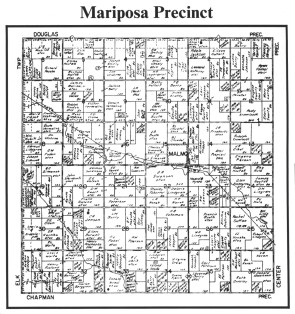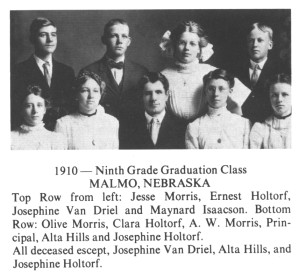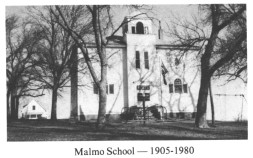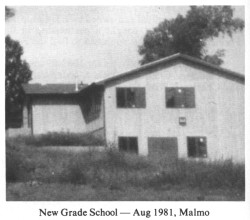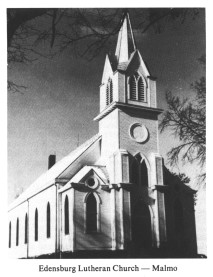MARIPOSA PRECINCT
The precinct was organized August 24, 1869. The settlement of Malmo, first called Edensburg, had its beginnings in 1886. This was the first Swedish settlement in the county with an organized church. Preacher Larson from Alma would preach there on Sunday evenings. He preached in Alma on a Sunday morning, afoot or horseback to Swedeburg in the afternoon, and on to Edensburg in the evening.
The Swedish families came by train to Council Bluffs, Iowa and here they hired a team for $50 and loaded the wagon with their belongings; the men, women, and children in all six families, were forced to walk. They followed the Missouri River down the Iowa side until opposite Plattesmouth, then ferried across and came to Ashland, fording Salt Creek and Saline Ford.
L. Isaacson was the first settler near the vicinity, coming to this country from Kristianstad Lan, Sweden, in 1868, and homesteading in the following Spring. It is recorded that Andrew Blomberg came two weeks later from Omaha with a colony of Swedes from Dalcadia.
The first newspaper in the community was the Malmo Clipper edited and owned by J.T. Camp. He sold it in 1893 and bought a partnership in the Fremont Flail. (He was supposed to flail the Populists.)
Mariposa Precinct officers for 1983-87 are Donald Lindgren, Chairman; Eula J. Peterson, Clerk; and Charles J. Proskavec, Treasurer.
VILLAGE OF MALMO,
NEBRASKA
The town of Malmo is situated in Section 15, Mariposa Precinct. It is a small but industrious and important town. This town is located on the Schuyler branch of the Burlington Railroad, with two trains each day.
Malmo had its beginning in 1886, at which time the town was surveyed on land purchased from Jerry Fisher. The names of Ostenburg, Bredenburg, Hulsing, Bostrom, Bruce, Blomberg, Rosenberg, Nelson, Larson, Ljungstrom, Olson, Frostrum, Hokanson, Erickson, Eliason, and Pherson are prominent among the early settlers of Malmo and vicinity. The first church was organized January 15, 1870.
Gus Bredenburg, Charles Hulsing and Ed Bostrom constructed the first store in the village in 1887. This was a general store. The firm of Marsh and Chapman put up the second store. The first hotel was owned and operated by Fannie Baldwin.
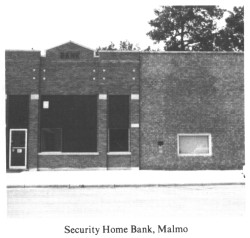 |
| Security Home Bank, Malmo |
THE FARMERS AND
MERCHANTS BANK OF MALMO
The Farmers and Merchants Bank of Malmo was started in 1892 by W.H. Ostenburg as a private bank. On March 4, 1893, the bank was incorporated by the following men: W.H. Ostenburg (cashier), J.C. Frahm, R.B. Van Driel (President), C.J. Harrison, Peter Riemers, D.E. Bridenburg (Vice President), John Frostrom, J.J. Johnson, C.W. Bruce, A.E. Larson, Edward Bostrom, and P.B. Olson. The first capital stock was $25,000, the same as at present. The institution carries a surplus fund of $5,000 and the deposits average $200,000 on the
year.
Peter Riemers was the President in 1915, C.W. Bruce was Vice President, Herman Lind was cashier, and W.H. and H.H. Ostenburg, J.C. Frahm, Christian Scow, M.S. Hills and Andrew Roslund were the directors. This bank has borne a steady reputation for splendid business methods and no bank in the county carries a greater amount of the dependency and faith of the people.
In 1948 the bank was moved to its present location and the name was changed to Security Home Bank. In 1982 the bank was remodeled. An Open House was held on August 8, 1982, to the public for this commemoration. Directors at this time are Donald Cejka, Amy Houfek, Abner H. Dauel, Wayne Barry, Mike Leicke, and H. Patrick Erickson. Donald Cejka is President of the bank and Mildred F. Pacal is the cashier.
WEST SIDE OF MAIN STREET,
MALMO
First business building on the south end of the block was owned by the Amberg Brothers, hardware and implements.
Art Frahm was the next owner, followed by Vaugh.
Bordovsky added general merchandise, groceries and furniture. Chas. and Frank Kastl also owned the place for a time.
Holtorf Brothers, (Jerry and Jack) bought the place in 1910. They discontinued the groceries and general merchandise. In 1912 they assembled about 15 harvesters for small grain. They were just becoming popular about that time.
Chas. Mantel bought the business from the Holtorf Brothers. He added a brick garage to the north side of the hardware building. He sold the property to the Volin Brothers, Jerry and Fred. On April 10, 1945 the Volin Brothers opened the Hardware and
Garage for business. They operated a fuel and gas truck to deliver to the community, since most of the heat was derived from fuel oil stoves. Farmers had gas delivered for their equipment. They helped in many community affairs, and were always available when called in emergencies. They were missed very much when they decided to retire in April of 1973.
An auction was held for two days, March 31 and April 1, 1973. The buildings were sold at auction also. Submitted by Josephine L. Jenny and Mrs. Elmer Pacal
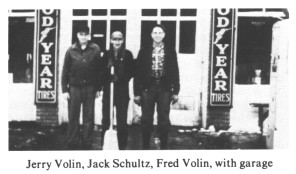 |
| Jerry Volin, Jack Schultz, Fred Volin, with garage |
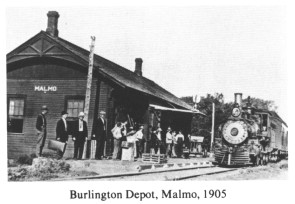 |
| Burlington Depot, Malmo, 1905 |
CHICAGO, BURLINGTON &
QUINCY RAILROAD
BURLINGTON DEPOT, MALMO,
NEBRASKA
The first depot was the standard or regular type depot that all the towns on the route had. Living quarters upstairs, depot office, baggage and freight rooms on the ground floor.
Fiddock was probably the first depot agent. Others are French, McFarland, Baumann, Melvin Pipkin and Cora Pipkin. Mrs. Pipkin was the last agent residing in Malmo. There was a section foreman's residence on the north side of the track. Situated a little west in the trees. Carl Moline was the first foreman. Swan Larson was the last.
THE PRESBYTERIAN CHURCH
MALMO, NEBRASKA
In the early 1900's a group of English families organized the Presbyterian congregation. Malmo had two Swedish congregations, the Edensburg Lutheran and the Mission Covenant and the St. John's German Lutheran, north of town.
The congregation bought a lot or two on the north end of main street on the east side and had a church built there. The congregation flourished for ten years or so. They had Sunday morning services, an active choir, Sunday School and also evening special services. A visiting pastor supplied them with the services.
Some family names supporting the church were: Bredenberg, Fay, Rogers, Yarrington, Staudinger, Bowen, Hills, Drs. Ross, Keyes, Emmett, Miss Harriet Frahm, and Miss Blanch Jones and others.
The church was dissolved about ten years later. Too many of the supporting families had moved away. Those remaining could not sustain it. The property was sold to Orpheus Kemerling, who remodeled it into a residence. The property is now the Larry Hauschild residence.
One or two summers in 1900 and 1901, Malmo also had services or revival meetings under a tent on Sunday afternoons or evenings. It was located on a vacant lot south of the Levi Isaacson residence, where Bessie (Wm) Dauel now lives. The Ockander family, who lived several miles east of Malmo furnished the music and accompanied the singing, with their stringed instruments, banjos, guitars, and the like. It was a real pleasure to sit on our porch or on the lawn to listen to the music. Submitted by Josephine L. Jenny
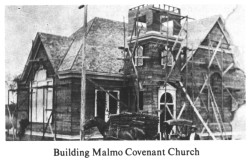 |
| Building Malmo Covenant Church |
COVENANT CHURCH
The Swedish Evangelical Lutheran Mission Association Bethesda Church was organized May 8, 1876. The original church was located 2 miles northeast of Malmo, Nebraska. At this time the church was under the leadership of Rev. John Peterson of Oakland. Then, in 1889 the church applied for membership in the Bethesda Evangelical Covenant Church of which it is presently a member. The second church was erected in Malmo, Nebraska in 1905 and was dedicated on February 4, 1906. Total cost of labor and materials was $8,512.81.
page 89
|

